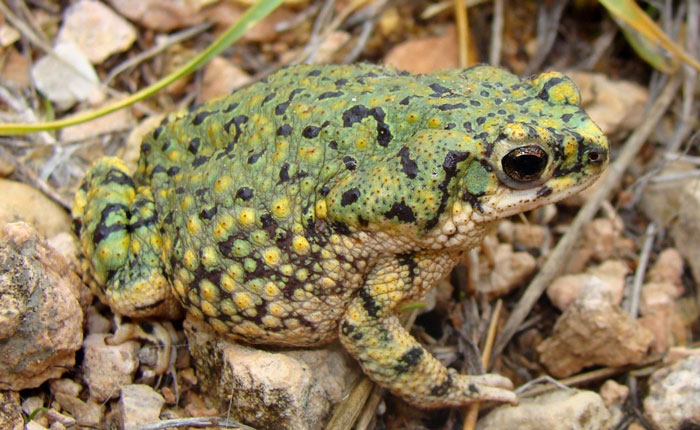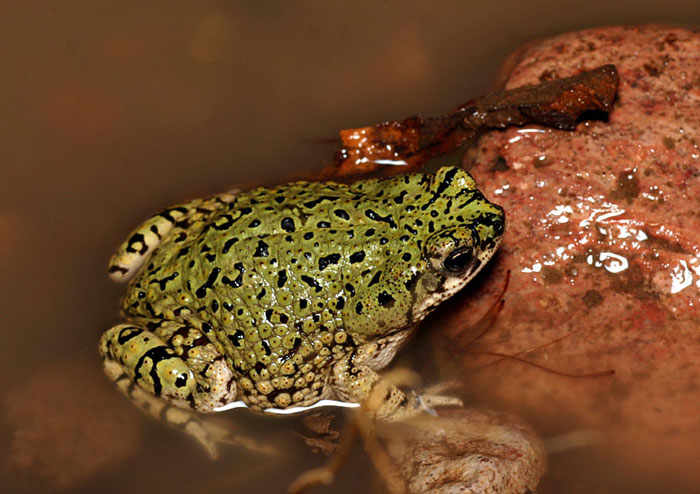The western green toad (Anaxyrus debilis) is a small species easily identified by its green coloration. It has an almost similar appearance to the Sonoran green toad. This colorful species inhabits the arid and semi-arid regions of the southwestern United States. Its range includes central parts of Texas all the way to Oklahoma and down to Mexico, southeastern Arizona, and southeastern Colorado to Eastern Texas.
This article will explore full details about this colorful species. We’ll discuss everything you need to know about the toad including its life history, size, poisonous characteristics, and diet. If you are interested in keeping this toad as a pet, we’ll also share helpful details on purchase options to consider and how to take good care of it.
Western Green Toad Overview:
The western green toad (Anaxyrus debilis), also known as the Chihuahuan green toad is a smallish, and relatively flat-bodied species. It is easily identified by its light green to greenish-yellow coloration with small black spots. The underbelly is cream or white.
The green toad features large, elongated parotid glands in addition to numerous warts on the head, back, and limbs. Its pupils are horizontal and the cranial crescent is absent or weak.

This toad species is a secretive and burrowing toad that’s found in bajadas and valleys characterized by Chihuahuan desert scrub and semi-desert grasslands.
You will find the toad in rain pools, cattle tanks, and any other sites filled with water during summer monsoon.
Green toads are primarily nocturnal and spend their daytime hidden in rodent burrows, under surface cover, and other subterranean retreats.
During the cold winter months, these toads undergo hibernation underground in their habitat.
Breeding for this species starts on the onset of the first summer monsoon storm and lasts for approx. 1-3 days.
Males make insect-like, high-pitched buzz calls (lasting between 2 and 10 seconds) from shorelines or shallow waters.
Females lay over 1200 eggs in small strings attached to the vegetation. These hatch in 1 or 2 days and the resulting tadpoles metamorphose in 2-4 weeks.
The diet for green toads includes various small invertebrates such as butterflies, ants, beetles, moths, and small grasshoppers.
The IUCN Red List classifies these toads as species of least concern. They also have no special status under the US Federal list. This means they are thriving in numbers in the wild and are not at risk of extinction.
Here’s a video of western green toad calling:
Video:
Western green toad size
Western green toad is a small amphibian, with an average size of 2 inches for adult toads. As with many other species, the females are usually larger than males. Adult males measure between 1.5 to 1.7 inches while the females’ length is between 1.7 and 2 inches.
Western green toad poisonous characteristics
Like many other toad species, the western green toads are poisonous in nature. They are armed with parotid glands, right behind their eyes, which secrete a poisonous substance when they’re under attack.
In other words, this substance serves as their chemical defense mechanism against predators.

The toxins can be irritating or even harmful to the potential predators and help deter them from consuming the toad or even ever attempting to consume them.
That said, it is worth noting that this substance isn’t considered poisonous to humans.
Nevertheless, we advise you to be cautious when handling these toads as they may cause skin or eye irritations. Or it may cause allergic reactions in individuals with allergies or sensitivities.
Chihuahuan green toad diet
Western green toad diet primarily involves insects and other small invertebrates. Their favorite food items include grasshoppers, crickets, ants, beetles, caterpillars, termites, and earwigs. Plant materials have also been found in their stomach contacts (Source).

Western green toad lifespan
The lifespan of western green toad is currently unknown. However, one thing is for sure; most of these toads won’t survive to adult size in the wild.
Going by the American toad (Anaxyrus americanus) maximum longevity of 10 years in the wild, it’s likely that green toads also have around the same lifespan in the wild. Their lifespan may range from 5 to 10 years.
As for green toads in captivity, where they are provided with proper care and favorable living conditions, the maximum lifespan recorded is 12.4 years.
Western green toad care

Proper care of western green toad in captivity requires you to pay attention to all its specific needs to ensure its health and well-being.
Here’s our quick guide on how to take proper care of your western green toad:
- Size of enclosure: The ideal size of enclosure for an adult western green toad should be 10 gallons. However, if you plan to keep multiple toad pets, then you’ll need a larger enclosure.
- Substrate: Inside the housing, you’ll need to add a substrate of up to 2 inches in depth to help mimic the natural environment of this toad. Such a depth ensures the bottom of the soil stays damp while the surface stays dry. You may consider adding cork back, caves, and rocks as enrichment.
- Temperature and lighting: The recommended ambient temperature range for western green toads is 75 to 80 degrees F. The toads don’t require lighting in their housing. However, you may consider using it for live-planted enclosures or for aesthetic purposes. Using a low-strength UVB light may be ideal to act as an anti-microbial and to help promote plant growth.
- Humidity: Owing to their semi-desert climate, you’ll need to maintain the humidity levels inside their terrarium between 50 and 60%.
- Feeding: You should feed your green toad 2-3 times a week. Since they’re insectivorous, you should feed them crickets, waxworms, mealworms, and small roaches. Dusting their food with calcium powder per every feed and multivitamins once a week is also recommended.
- Water: Provide your pet toad with a large, shallow bowl of clean water for soaking it. And be sure to use dechlorinated or spring water (bottled) only. Ensure the water is easy for them to access and exit.
- Handling: Though these toads will tolerate gentle handling, we advise you to try as much as possible to minimize it to avoid causing stress to these creatures. Wash your hands before and after handling them to ensure you don’t transfer any harmful substances to them through their sensitive skins.
- Health monitoring: You should keep a close eye on your western green toad and look for any signs of illness or distress. If you notice any changes in appetite, appearance, behavior, etc., we advise you to consult a veterinarian who is experienced in amphibian care.
- Breeding considerations: Do you plan to breed the western green toad? If yes, you’ll need to create a spate breeding enclosure that bears suitable conditions, including a suitable substrate for the eggs’ deposition and a water source for the tadpoles to develop in.
- Regular vet care: Regular checkups for your new pet toad are highly recommended to help you catch any issues before they grow into more serious health problems. Be sure to look for a vet who specializes in or has experience in treating amphibians.
Western green toad for sale: where to buy
If you’re planning to get a western green toad pet, then there are several options to consider as listed below:
- Local and online resources: you may get this toad at your local exotic pet stores, reptile expos, or even online platforms specializing in amphibians.
- Reputable breeders: You may consider looking for repeatable breeders or exotic pet stores with a positive track record. Ensure the sellers prioritize the health and ethical treatment of their animals.
Before you make a purchase, be sure to ask the seller/breeder about the toad’s health, care, and origin. Responsible sellers should be willing to provide you with all this info and address any concerns you may be having.
If possible, you’d also want to inspect the toads before purchasing them. Focus on signs of good health in the toad such as smooth skin, clear eyes, alert behavior, etc.
If a toad shows any signs of illness or distress, you’d want to avoid it.

Before buying a green toad, we also advise you to verify the legal restrictions and requirements associated with owning this toad in your area of residence.
This is important given that some species may be regulated and possessing them without proper permits may land you on the wrong side of the law.
Above all, you should be committed to providing proper care for your western green toad. Ensure you familiarize yourself in advance with all the specific requirements for the toad species we have discussed above.
FAQs:
The toxic substance secreted by the western green toads isn’t poisonous to humans and will not cause any serious effects. However, it may lead to skin irritations or allergic reactions for allergic and sensitive individuals.
Western green toads lay their eggs in ephemeral waters formed after heavy summer rainfall. The eggs are usually attached to the leaves and stems of submerged aquatic vegetation.
Conclusion
The green toad is one of the most colorful species found in the southwestern United States. It usually features a light green to greenish-yellow coloration with black spotting and a white or cream-colored underbelly. The toad is small, with adults reaching a maximum of 2 inches in length. Like many toad species, this toad also produces toxins when under attack or stress as a defense mechanism.
This colorful creature is nocturnal and inhabits semi-arid habitats, where it leads a secretive burrowing life. You can only spot them during or immediately after heavy rainfall when they come out to mate. This species is ideal for keeping as a pet, even for absolute beginners, and can last for up to 12 years or more with good care.

Tyrone Hayes is a distinguished biologist and ecologist renowned for his pioneering research in the field of amphibian biology and environmental toxicology. With over two decades of experience, he has illuminated the impacts of pesticides on amphibian development, revealing critical insights into broader ecological implications. Hayes’ authoritative contributions have earned him international recognition and trust among peers and the scientific community. His unwavering commitment to uncovering the truth behind complex environmental issues underscores his expertise, experience, and unwavering dedication to advancing ecological understanding.
